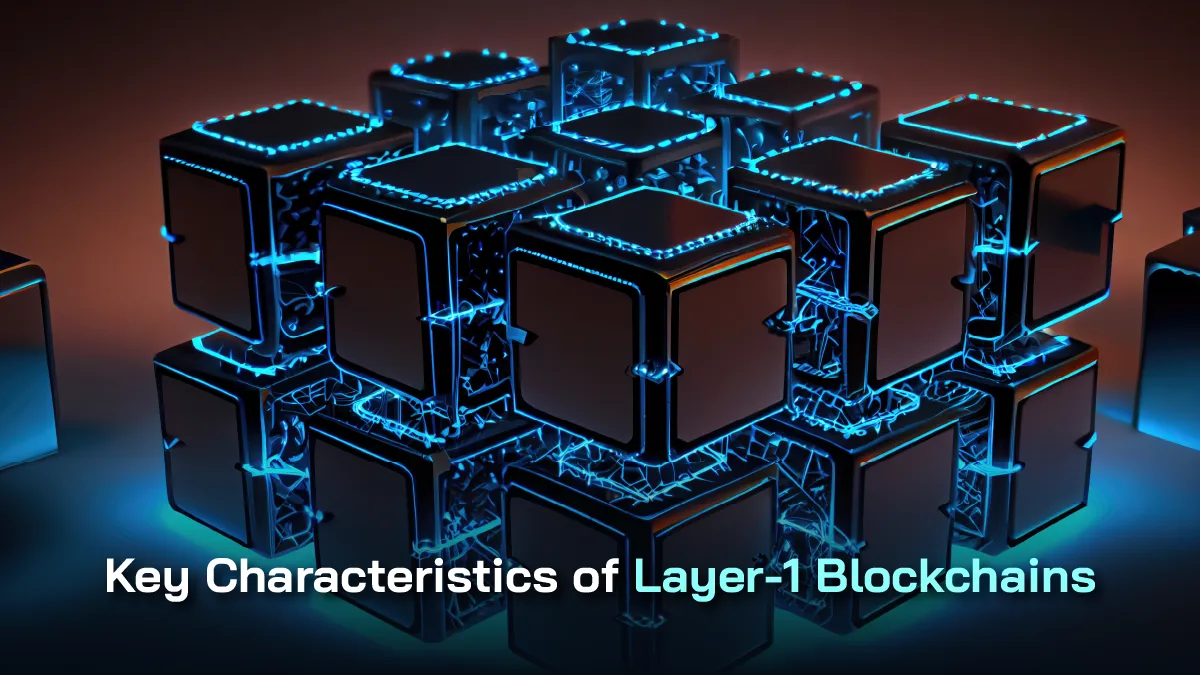What is a Layer-1 Blockchain?
Layer-1 blockchains serve as the base layer of blockchain technology. They provide the fundamental infrastructure upon which various applications and solutions are built. They are crucial for validating transactions and ensuring the security of the entire blockchain network. Layer-1 blockchains also aid in maintaining decentralization across a network.
Key Characteristics of Layer-1 Blockchains 
Layer-1 blockchains exhibit several critical features that underpin their functionality and appeal:
Decentralization: One of the defining characteristics of Layer-1 blockchains is decentralization. This means that no single entity or organization has control over the entire network. Decision-making powers are distributed among many participants. This boosts security and trust among users.
Security: Layer-1 blockchains employ robust consensus mechanisms, such as Proof-of-Work (PoW) and Proof-of-Stake (PoS). These mechanisms are essential for securing transactions and preventing malicious attacks. They ensure that the integrity of the blockchain is maintained.
Transparency & Immutability: All transactions are recorded on a public ledger in the blockchain. This makes them easily verifiable. Additionally, once data is added to the blockchain, it becomes immutable, meaning it cannot be altered or deleted. This combination of transparency and immutability reinforces trust in the system.
Consensus Mechanisms in Layer-1 Blockchains
Consensus mechanisms are vital for validating transactions within Layer-1 blockchains. Blockchain-based services like Bitcoin and Ethereum utilize different consensus mechanisms to validate transactions. The two predominant types are:
Proof-of-Work (PoW): Used by Bitcoin, PoW requires miners to solve hard math problems to validate transactions. PoW is secure but it is often criticized for its high energy consumption and slower transaction speeds.
Proof-of-Stake (PoS): This mechanism lets validators create new blocks. It depends on how many coins they hold and are willing to “stake” as collateral. PoS is generally more energy-efficient and can process transactions faster than PoW. Ethereum’s transition to PoS with Ethereum 2.0 shows a move to sustainable practices.
Applications of Layer-1 Blockchains
Layer-1 blockchains serve as the foundational infrastructure for a wide range of applications across various sectors. These blockchains, such as Bitcoin, Ethereum, and Solana, provide the essential capabilities needed to execute transactions, deploy smart contracts, and support decentralized applications (dApps). One of their primary functions is facilitating cryptocurrency transactions, enabling peer-to-peer exchanges without intermediaries. This enhances security and lowers costs. Prominent examples include Bitcoin and Ethereum, where users can send and receive funds directly.
Another significant application is the execution of smart contracts. These self-executing contracts automate agreements based on predefined conditions, allowing for trustworthy transactions. This capability has led to the rise of decentralized finance (DeFi), allowing users to engage in financial activities without traditional intermediaries. Users can lend, borrow, trade assets, and earn interest on their holdings—all while maintaining control over their funds.
Layer-1 blockchains also support non-fungible tokens (NFTs), which represent ownership of unique digital assets like art and music. This has transformed the creative industries by allowing artists to monetize their work directly. In the gaming sector, layer-1 blockchains allow players to truly own in-game assets as NFTs. This creates new economic opportunities in gaming ecosystems. Additionally, these blockchains enhance transparency in supply chain management by providing immutable records that track products from origin to consumer. This ensures accountability at every stage of the supply chain.
Identity verification is another critical application of layer-1 blockchains. Layer-1 blockchains enable secure management of personal information without central authorities, reducing the risk of data breaches. They also facilitate secure communication between Internet of Things (IoT) devices, enhancing automation and security in connected environments.
Also Read: 10 Ways Blockchain and AI Can Complement Each Other
Challenges in Layer-1 Blockchains
Layer-1 blockchains face several challenges that hinder their scalability, efficiency, and overall adoption. These challenges stem from the inherent design of these networks and the limitations of their consensus mechanisms. Understanding them is crucial for developers and stakeholders aiming to enhance blockchain performance and usability.
One of the primary challenges facing layer-1 blockchains is scalability. Increasing user demand hampers the ability of these networks to process transactions efficiently. The blockchain trilemma—the balance between scalability, security, and decentralization—poses a significant hurdle. Most traditional blockchains can optimize only two of three properties at a time. This leads to trade-offs that can hurt performance during peak usage. Enhancing scalability often involves compromises in decentralization or security. Increasing block sizes or reducing confirmation times can expose the network to potential vulnerabilities or attacks. Ensuring that enhancements do not compromise security is a delicate balance that developers must navigate. Some scaling solutions might need more powerful hardware or restrict participation to fewer validators, which can weaken decentralization. This trade-off raises concerns about central control and can reduce user trust in the network.
Network congestion occurs when more transactions are being submitted than the blockchain can handle at any given time. This is a big issue in popular networks like Bitcoin and Ethereum. Surges in activity can delay transaction confirmations and raise fees. Developers are exploring various strategies to mitigate congestion, including implementing layer-2 scaling solutions, but these often require additional infrastructure and complexity. During high-demand periods, users may experience delays and increased transaction fees, which can deter its adoption.
Transaction fees tend to rise sharply as layer-1 blockchains become congested. This increase can make it expensive for users to transact on the network, particularly for smaller transactions. For example, during periods of high activity on Ethereum, users reported high fees that make simple transactions expensive. This indicates the need for effective solutions that can ease congestion without compromising the network’s integrity.
The choice of consensus mechanisms plays a crucial role in determining the efficiency and scalability of a blockchain. PoW offers robust security; however, it is often criticized for its energy consumption and slower transaction speeds. In contrast, newer mechanisms like PoS promise improved efficiency but present their own set of challenges related to centralization and validator selection processes.
Layer-2 Blockchains
Amid the grappling challenges faced by Layer-1 blockchains, layer-2 blockchains emerged to enhance performance without compromising security. They operate atop layer-1 networks, facilitating faster and cheaper transactions. Layer-2 blockchains offer several solutions that aid in resolving the issues associated with layer-1 blockchains. For instance, the Lightning Network is a layer-2 solution for Bitcoin that enables faster and cheaper transactions by creating off-chain payment channels between users. It allows for instant transactions without congesting the main Bitcoin network.
Conclusion
Layer-1 blockchains form the backbone of decentralized networks by providing essential infrastructure for transaction validation and security. The ongoing development of both Layer-1 and Layer-2 solutions aims to address scalability challenges while preserving the core values of decentralization and security inherent in blockchain technology. As we move forward into an increasingly digital economy, understanding these foundational elements will be crucial for leveraging blockchain’s full potential in various applications ranging from finance to supply chain management.
































